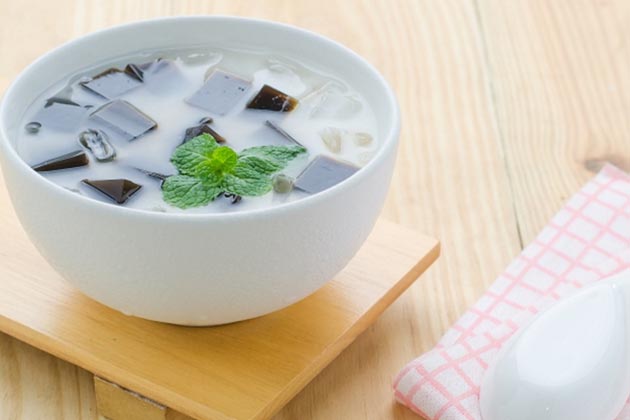Is black grass jelly Asia’s hottest new trend?

What is black grass jelly?
Black grass jelly is one of the hottest new trends coming out of Asia and is beginning to penetrate other markets – particularly the US.
The usage of black grass jelly in desserts has been relatively common in Thailand and Southeast Asia for around a century, so to call it a ‘new’ trend is somewhat misleading; however given its sudden rise to prominence in retail, it certainly feels like a brand new trend.

Black grass jelly starts life as a herb/grass from the ‘Mesona Chinensis/Chinese mesona’ species which is itself part of the mint family.
Immediately after harvesting, the grass has very little fragrance until it undergoes a yearlong drying process, after which the odour begins to develop and it takes on a sweet but slightly herbal flavour.

The Chinese mesona is cultivated primarily in Taiwan, before being harvested, dried and made into grass jelly.
Black grass jelly is primarily consumed as a dessert, but also serves as a popular drink for quenching thirst in the tropical climates where it is most popular.
Asia’s hottest trend?
Despite over a century of usage in Asia, black grass jelly launches have skyrocketed in 2016, growing by an enormous 440% in the Asia Pacific region (Mintel GNPD).

This traditional sweet has suddenly found a new lease of life, driven primarily by the continued growth of bubble tea in both Asia and further afield.
Recently, some consumers have been favouring grass jelly as an alternative to the usual tapioca boba bubble tea, particularly following some claims that tapioca tea may in fact include carcinogens.
This wider change in attitude has led to a number of consumers returning to grass jelly, and retailers looking to service this demand, with many brands across the Asia Pacific region launching canned and bottled ready to drink grass jelly teas.
Black grass jelly – the healthy choice?
Part of the appeal of grass jelly (as well as it’s highly unique taste profile) is the health benefits associated with the product.
Functional foods continue to grow at an exponential rate in almost all regions of the globe as people look not just to cut down on ingredients which are bad for them, but also to start incorporating ingredients which are actively helping improve health.
Globally, claims such as ‘added minerals/vitamins’ (74% of launches), ‘other (functional)’ (25.6%) and ‘high/added fiber’ (16.8%) are amongst the most commonly found on beverage packaging (Mintel GNPD).
Although much of the evidence remains anecdotal, there have been numerous blogs citing black grass jelly as helping with the healing of stomach ulcers, fever and even high blood pressure.
As such, we are beginning to see a perfect storm in Asia as people move away from tapioca amid cancer claims and opting for the perceived health benefits of black grass jelly.
But what about outside of Asia?
Primarily a drink and dessert choice of a number of Southeast Asian countries, black grass jelly has slowly begun to spread to other parts of the world, as people in Europe and America embrace this traditional Asian sweet.
As well as a completely unique flavour and texture profile, part of black grass jelly’s appeal in the USA and Europe stems from the health benefits which have been linked to the drink.
Overall, retail launches outside Asia Pacific (which accounts for 95.2% of launches) have been fairly limited with the Middle East & Africa accounting for 2.4% and both Europe and North America accounting for 1.2% of launches (Mintel GNPD).
Outside of retail, however there is a bit more of a trend starting to develop, particularly in North America which has already embraced bubble tea in a big way.
As people in the US and Europe become more familiar with the bubble tea concept, they are becoming increasingly adventurous and willing to try more niche teas, such as grass jelly.
What next for black grass jelly?
Although it remains relatively niche outside of Asia… inside of Asia, grass jelly looks set to expand well beyond small street food vendors, and into the mainstream.
With all the furore surrounding bubble tea, there is ample opportunity for grass jelly to steal the spotlight as one of the region’s biggest drinks.
Outside of Asia, the opportunities are less obvious, however if grass jelly continues to grow in Asia, it’s hard not to see it making the leap to the US and Europe – even if, like bubble tea, it remains limited to specific Asian supermarkets and niche tea outlets.
Getting in touch
At Synergy Thailand, we have an expert team of flavour creation specialists as well as applications technologists. As a result, not only can Synergy offer localised manufacturing in Asia, but we can also make sure that whatever the latest trends coming out of the region are, we are always on top of them.
For more information on black grass jelly, or to learn more about Synergy’s manufacturing capabilities in Thailand and Asia, please visit our global locations page, or contact the Synergy Thailand team by email [email protected] or by phone: +66 2 181 6710.
insights

